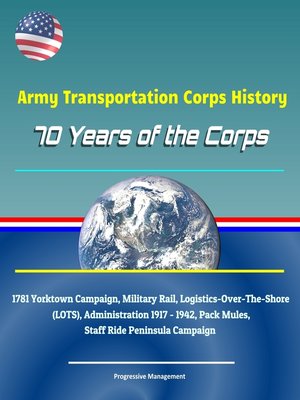Army Transportation Corps History
ebook ∣ 70 Years of the Corps, 1781 Yorktown Campaign, Military Rail, Logistics-Over-The-Shore (LOTS), Administration 1917--1942, Pack Mules, Staff Ride Peninsula Campaign

Sign up to save your library
With an OverDrive account, you can save your favorite libraries for at-a-glance information about availability. Find out more about OverDrive accounts.
Find this title in Libby, the library reading app by OverDrive.



Search for a digital library with this title
Title found at these libraries:
| Library Name | Distance |
|---|---|
| Loading... |
This compilation of seven excellent reports has been professionally converted for accurate flowing-text e-book format reproduction. The official historian of the Army Transportation Corps provides great histories of many Transportation Corps events:
1. 70 Years of the Transportation Corps * 2. Logistical Operations during the Yorktown Campaign, 1781 * 3. Use of Military Rail by U.S. Army * 4. The History of Logistics-Over-The-Shore (LOTS) Operations * 5. The Administration of Transportation in the United States Army April 1917 - March 1942 * 6. Pack Mules * 7. Staff Ride Peninsula Campaign
On 31 July 1942, the Department of War recognized the need for a single manager of Army transportation and created a new branch, the Transportation Corps. Since the Revolutionary War, Army transportation had evolved through two branches, the Quartermaster Corps and the Corps of Engineers. The demands of World War I made the Army first realize its need for a single manager for military transportation. So began an evolution over the next quarter century that culminated in the birth of the Transportation Corps during the opening months of World War II. Transportation as a function has existed from the beginning of American military history. The Quartermaster Department was long responsible for wagon and boat transportation, except for harborcraft; responsibility for harborcraft resided with the Corps of Engineers since it had the mission of maintaining ports. When the Army adopted the use of military railroads during the Civil War, that function also fell to the Corps of Engineers since it was responsible for repairing tracks and building bridges. During the 19th century, the Army was too small to require much specialization. So transportation requirements during peacetime could be managed by the Quartermaster Department. During war, however, the need for military transportation habitually expanded into organizations that managed the different modes, such as wagons, boats, and railroads. [The Quartermaster, Subsistence, and Pay Departments were consolidated in 1912 to create the Quartermaster Corps.]







